Part 5:
More Viewings of Edwin S. Porter's Kinetoscope Films
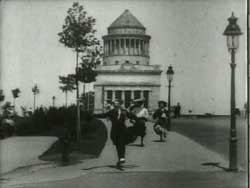 A film with an unweildy title, How a French Nobleman Got a Wife Through the New York Herald Personal Columns (1904) was an Edison Company remake of the American Biograph comedy hit Personal (1904) directed by Wallace McCutcheon.
A film with an unweildy title, How a French Nobleman Got a Wife Through the New York Herald Personal Columns (1904) was an Edison Company remake of the American Biograph comedy hit Personal (1904) directed by Wallace McCutcheon.
Siegmond Lubin made a satiric version Meet Me at the Fountain (1904), as if the story weren't satiric enough already. In Lubin's film the old maid who answers the personal ad is the world's ugliest transvestite.
At eight minutes How a French Nobleman Got a Wife draws out what is a fairly minor jest, approaching the length of one-reeler comedies from the following decade, this at a time when kinetoscope films averaged two minutes.
The story was purported to have actually happened, when a young French nobleman placed a personal ad in the New York Herald seeking an American bride, proclaiming that he will be weaitintg for her by Grant's Tomb at 10 A.M. wearing violets as a boutonniere.
Certainly "matrimonial advertisements" were a commonplace at the time, but this amusing bit of urban folklore was pure jest, despite that it was widely believed.
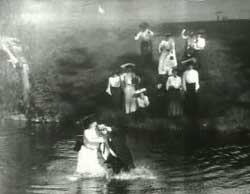 We first meet the slim nobleman in his private apartment getting dressed for the hoped-for morning encounter. He arrives early at Grant's Tomb & st ruts about until first one, then another woman appears to him, then a third, & so on until he is surrounded by women. We first meet the slim nobleman in his private apartment getting dressed for the hoped-for morning encounter. He arrives early at Grant's Tomb & st ruts about until first one, then another woman appears to him, then a third, & so on until he is surrounded by women.
He bows to each in pleasant greeting until they've quite worn him out & close in upon him like a pack of dogs on a bone. He takes off running for his life, well-dressed women in hot pursuit.
One of the first great chase scenes of the motion pictures procedes, very handsomely photographed at various locations through which our young nobleman takes flight. In the park, he stumbles, rolling down a hill, the eager brides swift on his tail.
He comes to a drop-off to the dunes & barely hesitates before jumping to the sand below. One after another the women bound over the ledge. Throughout the chase, a slightly overweight woman is furthest behind.
Through sundry environments the long chase continues until the nobleman comes to a pond & wades out to a depth. The women accumulate along the shore, imploring him to return to them. He in an absolute panic just motions to them to go away.
Finally the slowest woman in the chase arrives at the banks & without the least hesitation bypasses the swifter women & wades out to claim her titled husband.
He rather endearingly accepts her embrace & assistance at this moment of emergency in his life. Supported by her, they wade out of the picture, leaving the other women standing in a gaggle near the water's edge.
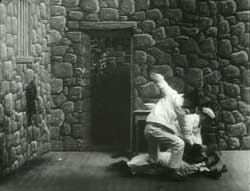 Maniac Chase (19040 is a remake of the American Biograph comedy, A. E. Weed's The Escaped Lunatic (1904). Maniac Chase (19040 is a remake of the American Biograph comedy, A. E. Weed's The Escaped Lunatic (1904).
Such piracies were mutual, so it was hard for any one company to claim the high ground. But the Edison Manufacturing Company had so much more weight behind it, & delight in cutthroat business tactics, they could really make life tough for rival studios.
Porter, however, just wanted to make fun films, & when taking some other company's film to remake into something like How a French Nobleman Got a Wife or Maniac Chase, he tried always to do it with sparkling effect.
In the cold, stone-walled, bleak cell of an insane asylum, a chap is permitted to dress as Napoleon, who he believes himself to be. In exchange for allowing him to dress as he chooses, the orderlies get the beat the living daylights out of him whenver they're annoyed with him.
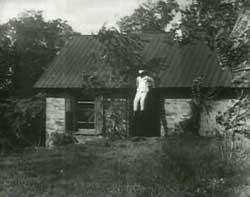 One day he's mildly abnoxious with an orderly, splashing the guy with the nasty gruel unfit for an Emperor. So three orderlies lay into him something fierce. One day he's mildly abnoxious with an orderly, splashing the guy with the nasty gruel unfit for an Emperor. So three orderlies lay into him something fierce.
Alone with his bruises, he breaks a leg off the table & uses it to pry one of the bars loose on the window. Soon he's fleeing down a wooded lane with the abusing orderlies in pursuit.
The madman tries to gain some distance by rolling down a hill in a wine barrel, which isn't much help really.
There's a bit of trick photography as our phony Napoleon & the orderlies jump miraculously into a tree, & come down elsewhere in the woods as though they'd been chasing through the treetops. The madman now & then relaxes to take Napoleon poses as popularized in sundry portraits.
Over a haystack, over the roof of a country home, down a road the chase continues. At a bridge Napoleon turns to confront the nearest of his pursuers, lifts him above his head, & tosses him off the bridge into the river. I wonder if this is the first cinematic case of a maniken serving as stunt double?
Finally the maniac takes refuge in the insane asylum & sits at his table (no longer missing the leg he ripped off, by the way). He's now entirely calm, as though he'd never done a thing wrong that day.
Maniac Chase has a funny ending but the chase overall is not the equal of the chase that occurs in How a French Nobleman got a Wife.
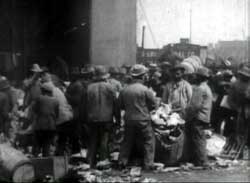 I love these old films but the weakest for me tend to be the "actualities," although there certainly are exceptions.
I love these old films but the weakest for me tend to be the "actualities," although there certainly are exceptions.
I think just about anyone nowadays would prefer the ones with jests or stories to tell, though for historicity, the actualities are great windows onto streets & peoples & places & events & modes of transportation. And some of them really are quite intriguing.
One such is Sorting Refuse at Incinerator Plant, New York City (1903). A garbage dump on the Hudson River is the location of this startling record of unskilled labor.
Men & boys in great numbers crawl amidst the refuse, packing bags with combustible materials, mainly paper. In the background, a man can be seen dumping barrels & boxes of garbage from a wagon.
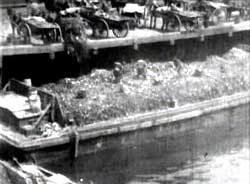 This was part of a "series" that showed the dark side of New York City life. I don't know how many films may have been in this series, but two others for certain are New York City "Ghetto" Fish Market (1903) & New York City Dumping Wharf (1903). This was part of a "series" that showed the dark side of New York City life. I don't know how many films may have been in this series, but two others for certain are New York City "Ghetto" Fish Market (1903) & New York City Dumping Wharf (1903).
Porter was assisted on these two by James Blair Smith, who was a camera assistant on Porter's most famous film The Great Train Robbery (1903).
New York City Dumping Wharf shows the city's trash being dumped from horse-drawn wagons & carts along the long edge of a dock, onto barges just like today's garbage barges of New York.
Laborers on the barge beneath the carts very nearly get waylaid by falling trash, as they rake or shovel it more evenly over the barge. The location is unknown, but a good guess is the East River.
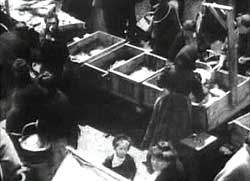 Halfway through the film, thje camera pans left to another barge against the dock, which appears to receive dirt for landfill rather than garbage. Halfway through the film, thje camera pans left to another barge against the dock, which appears to receive dirt for landfill rather than garbage.
New York City "Ghetto" Fish Market is thought to have been somewhere on or near Hestor Street in the Jewish neighborhood, on New York's Lower East Side. Here pushcart vendors gathered a thousand strong.
Shot from above, we see wheeled tables set up for wares (mainly fish) & a considerable crowd of immigrant shoppers. Three officious looking gentlemen walk through. They are probably from the city health department.
The camera begins to pan along the narrow path between vendors, following the officials, who must know they're being filmed since they'd otherwise be taking bribes.
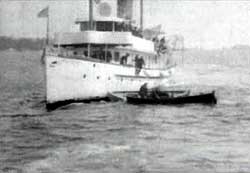 See also the review of Alfred C. Abadie's Move On (1903) also showing cart vendors on the Lower East Side & perhaps intended as part of the same "lower classes" series of films. See also the review of Alfred C. Abadie's Move On (1903) also showing cart vendors on the Lower East Side & perhaps intended as part of the same "lower classes" series of films.
James Blaire Smith was additionally the cameraman or assistant on Porter's New York Harbor Police Boat Capturing Pirates (1903). A "twin screw" police boat is shown picking up the pirates in a large rowboat.
This was a staged event in New York Bay, with a hint of Fort Lafayette visible in the distance. If it was intended as one of the "dark side of New York" series it doesn't succeed like Sorting Refuse because this one is not natural & real. It's more like a little adventure film.
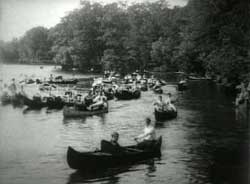 Porter positioned his camera on a bridge overlooking the river to shoot Canoeing on the Charles River, Boston, Mass (1904), another "actuality film" that delights for for providing a view into ordinary family past time. Porter positioned his camera on a bridge overlooking the river to shoot Canoeing on the Charles River, Boston, Mass (1904), another "actuality film" that delights for for providing a view into ordinary family past time.
Canoeing on the calm river was a popular summer past-time. But as we see the beginning in the distance of the procession of many canoes coming toward the camera, so this is not a random event.
The canoes wouldn't be clustered so close together if they'd been launching at different times on that July afternoon. So this is a recreation "actuality" rather than a pure event captured as it happened, which was a common method of going about it. When film shoots were only a couple minutes at a crack it was not easy to leave the actuality to chance.
The canoers are trying to slow down their approach in order to make sure they get well & included in the camera's eye before veering aside.
Porter has created a fine composition with the sweep of the tree-lined shore & the river going off into the distance.
As the canoes pass by the camera at an angle, Porter adjusts the composition slightly to the left to keep canoes in sight longest, & thus reveals that the canoers have begun to paddle round & round in a large circle in order to be photographed again, doubtless according to Porter's instruction beforehand.
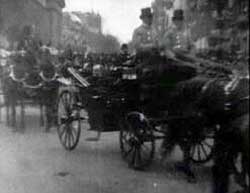 A veritable newsreel actuality captured at President McKinley's inauguration, Porter set up his camera at Pennsylvania Avenue & 15th Street to capture the inauguration parade, resulting in President McKinley & Escort Going to the Capitol (1901).
A veritable newsreel actuality captured at President McKinley's inauguration, Porter set up his camera at Pennsylvania Avenue & 15th Street to capture the inauguration parade, resulting in President McKinley & Escort Going to the Capitol (1901).
In order of appearance see dressy mounted police, then some muckly-mucks afoot, further bigshots on horseback, then the president's personal military escort, Troop A from Cleveland, in their fur caps & their sabres drawn & shouldered looking rather Prussian.
There follows America's brand new President seated to the right of Senator Marcus Alonzo Hanna, in a rather simple wagon drawn by four big horses which were McKinley's own personal animals. Following the President's wagon are other politicians & dignitaries in their carriages. The fifth carriage is Admiral Dewey's. Coming up the rear are Westpoint cadets marching in smart dress uniforms.
The Edison catalog promised that last of all there would be seen the Veterans of the 23rd Volunteers of Ohio, but the version I saw ends with the cadets.
It seems a mite odd that the sidewalks are void of people watching this impressive parade. There are so many buildings along that stretch, one would expect everyone to come outside to watch.
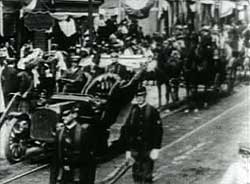 Scenes & Incidents, Russo-Japanese Peace Conference, Portsmouth, N.H. (1905) is a news film which I found mostly boring, & couldn't see that Porter did much with it beyond making it longer than most such films would've been at the time.
Scenes & Incidents, Russo-Japanese Peace Conference, Portsmouth, N.H. (1905) is a news film which I found mostly boring, & couldn't see that Porter did much with it beyond making it longer than most such films would've been at the time.
It is given in four chapters with separate subtitles to each section, originally to be viewed in consecutive kinetoscopes. Each part had to have something to it interesting enough to induce the contemporary viewer to drop a nickel in the next machine for the next part
. But a
Because the chapters could be purchased separately by kinetoscope parlors & other exhibitors, the whole film needn't necessarily be offered to patrons; the "parade" chapter might thus have been seen more than the other parts.
After a subtitle card to part one "Departure of Envoys for Oyster Bay, L.I." we begin with well dressed fellows in tophats at the New York Yacht Club wharf, boarding small passenger ferries operated by navy men.
The second part's subtitle is "Admiral Mead & Staff Receiving Envoys, Portsmouth Navy Yard." Here the Japanese & Russian envoys disembark from their respective ferries to official greetings. The docking of the first ferry which is a smoke steamboat was kind of interesting, but mainly it's hard to imagine anyone would pay a nickle for part three after the nothin' much of part two. Still, I stuck to it.
The third scene's subtitled "Reception at Court House." It's more colorful as it begins with a little parade which numerous people have lined up along a city street to observe. Parade films were common even without an international political event attached.
There's a band (to which I could not help but add in my imagination a speeded up rendition of "Seventy-six Trumbones), followed by a great many military men in full dress uniforms with enormous rifles which are of course the ideal symbols for peace conferencing, & for whose feet my imagination added the sound of "tramp tramp tramp tramp" just to entertain myself.
After the gunners there's an early automobile carrying dignitaries & behind them horse-drawn carriages. At the courthouse there's a huge crowd of onlookers, so this was obviously one hell of a big deal, America acting for peace mediation for Russia & Japan, who to this day don't like each other so we must not have done a bang-up job.
The finale is "Envoys Leaving Hotel Wentworth." Carriages & motorcars pick up the envoys & haul them away, & even the few people who were still hanging around aren't paying attention by then. We are never shown any scene or incident that has to do with the actual mission of the event. And this is, overall, one of Porter's less interesting films.
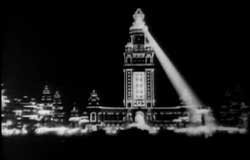 Arthur White, the brother of James H. White, assisted Porter on camera for Pan-American Exposition by Night (1901) & Panorama of Esplanade by Night (1901).
Arthur White, the brother of James H. White, assisted Porter on camera for Pan-American Exposition by Night (1901) & Panorama of Esplanade by Night (1901).
Night photography of events lit up by electricity was something the Edison Manufacturing Company had self-serving reasons to photograph, & Porter did it superbly at the Pan-American Exposition, as he would later do back in New York, for Coney Island by Night (1905).
The Exposition was in Buffalo, New York. Porter made other films with the White brothers while at the 1901 Exposition, & I previously reviewed his Circular Panorama of Electric Tower & Panoramic View of Electric Tower from a Balloon, the latter not really from a balloon. The "Esquimaux Village" films reviewed on the same page are likewise from this Exposition.
For Pan-American Exposition by Night, the panoramic sweep begins in the daylight hours & covers everything from the domed Temple of Music to the Electric Tower.
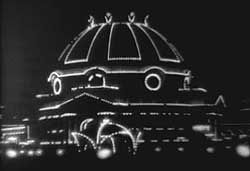 Then, vastly more amazingly by night, the full-circle panoramic view continues practically unbroken, from the Electric tower back to the Temple of Music. It's like a city of light on the dark side of the moon. Then, vastly more amazingly by night, the full-circle panoramic view continues practically unbroken, from the Electric tower back to the Temple of Music. It's like a city of light on the dark side of the moon.
They made two films that night, the first one having been Panorama of Esplanade by Night (1901). Porter claimed it was the first film ever made of incadescent lighting at night.
It's pretty much the exact same full circle panorama, except half of it isn't by day. The other one is more interesting not just because it shows day & night for comparison, but also the Electric Tower as shown Pan-American Exposition by Night is flashing its spotlight in several directions in rapid succession, so fast & so bright that it's almost scary & seems like special FX.
The tower is not flashing in Circular Panorma, so it's restricted to the luminous strings-of-pearls effect of buildings visible only by their electrically lit outlines.
copyright © by Paghat the Ratgirl
|
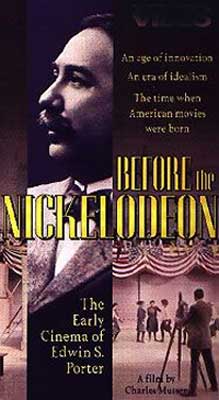

 We first meet the slim nobleman in his private apartment getting dressed for the hoped-for morning encounter. He arrives early at Grant's Tomb & st ruts about until first one, then another woman appears to him, then a third, & so on until he is surrounded by women.
We first meet the slim nobleman in his private apartment getting dressed for the hoped-for morning encounter. He arrives early at Grant's Tomb & st ruts about until first one, then another woman appears to him, then a third, & so on until he is surrounded by women.
 One day he's mildly abnoxious with an orderly, splashing the guy with the nasty gruel unfit for an Emperor. So three orderlies lay into him something fierce.
One day he's mildly abnoxious with an orderly, splashing the guy with the nasty gruel unfit for an Emperor. So three orderlies lay into him something fierce.
 This was part of a "series" that showed the dark side of New York City life. I don't know how many films may have been in this series, but two others for certain are New York City "Ghetto" Fish Market (1903) & New York City Dumping Wharf (1903).
This was part of a "series" that showed the dark side of New York City life. I don't know how many films may have been in this series, but two others for certain are New York City "Ghetto" Fish Market (1903) & New York City Dumping Wharf (1903). Halfway through the film, thje camera pans left to another barge against the dock, which appears to receive dirt for landfill rather than garbage.
Halfway through the film, thje camera pans left to another barge against the dock, which appears to receive dirt for landfill rather than garbage. See also the review of Alfred C. Abadie's
See also the review of Alfred C. Abadie's 



 Then, vastly more amazingly by night, the full-circle panoramic view continues practically unbroken, from the Electric tower back to the Temple of Music. It's like a city of light on the dark side of the moon.
Then, vastly more amazingly by night, the full-circle panoramic view continues practically unbroken, from the Electric tower back to the Temple of Music. It's like a city of light on the dark side of the moon.